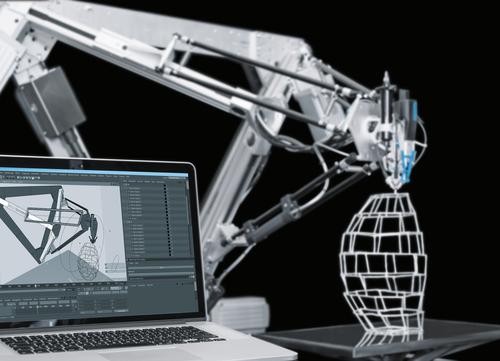When Manufacturing Becomes a Video Game
Advances in manufacturing are pushing the plant toward a fully digital operation with flexibility, speed, and efficiency.
September 9, 2016
If the industrial world wants to lure millennial grads to the manufacturing floor, maybe they should tell the grads the factory has become a video game. In his session at the ATX Automation Technology Conference in Minneapolis on Sept. 21, Tom Geiger, head of electric automation, Americas at Festo, will explore the boundaries of automation. He’ll describe a not-too-distant future of robotics and machine learning spun together like a virtual reality game.

The 3D Cocooner combines the advantages of additive manufacture with the precise control and agility of an industrial high-speed handling system, all while directed from a computer screen.
(Source: Festo)
Geiger’s session, Working Smarter, Not Harder: Human Collaboration with Robotics and Automation, will look at science-fiction-like issues such as moving from machine learning to cognitive computing that will enable robotics and automation to make creative decisions in case of planned or unplanned changes. Geiger envisions a plant where machines can order their own supplies when needed, eliminate repetitive tasks, enlarge manufacturing capacity, and provide faster output -- all by themselves.
Geiger explains the plant he envisions would be operated much like a video game, where the operators move machine data around on a computer screen and the equipment on the floor responds. “The lines between the real and digital plants are merging at a breathtaking pace,” Geiger told Design News. “Does this mean we’ve achieved the goal of the truly virtual modular flexible machine? In one word … no. We can build a model of a mechanical machine, we can put it online and connect it to the network, but, it’s like having a smartphone without the ability to play Pokémon Go.” In other words we’re not quite there. Yet we’re moving in that direction.
 Working Smarter, Not Harder. Tom Geiger will talk about robots on the market and in development, interpreting machine-driven data to create future business strategies and operation plans, and understanding the big picture investment and potential downsides, during the Industry 4.0 session, Working Smarter, Not Harder: Human Collaboration with Robotics and Automation at Automation Technology. Sept. 21-22, 2016 in Minneapolis. Register here for the event, hosted by Design News’ parent company, UBM.
Working Smarter, Not Harder. Tom Geiger will talk about robots on the market and in development, interpreting machine-driven data to create future business strategies and operation plans, and understanding the big picture investment and potential downsides, during the Industry 4.0 session, Working Smarter, Not Harder: Human Collaboration with Robotics and Automation at Automation Technology. Sept. 21-22, 2016 in Minneapolis. Register here for the event, hosted by Design News’ parent company, UBM.
Reaching the fully digital plant is all in the pacing. It will take some time for the possible to become the practical, especially when it comes to budgets. “The most important issues for companies today is to know how far to push in the short term,” said Geiger. “Trying to go too far into the virtual world with the current software and systems can dramatically increase costs and expand timelines on projects because the bridges have not yet been built.”
The promises of advanced manufacturing are heady -- automated equipment that changes from one product to another with the push of a button and machines that can learn how to improve their output without human coaxing. “Companies like Festo are helping build the bridges between the real and virtual,” said Geiger. “We believe Industry 4.0 is near at hand, and are working with other global companies to achieve standards, interfaces, and new techniques to integrate mechatronic systems.”
READ MORE ARTICLES ON ADVANCED MANUFACTURING:
Rob Spiegel has covered automation and control for 15 years, 12 of them for Design News. Other topics he has covered include supply chain technology, alternative energy, and cyber security. For 10 years he was owner and publisher of the food magazine Chile Pepper.
About the Author(s)
You May Also Like





